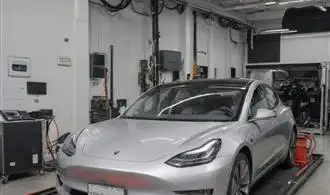
Performance and Handling
As a Tesla Model 3 owner for over a year, I can attest to the impressive performance and handling capabilities of this all-electric vehicle. The instant torque and responsiveness of the electric motor provide an exhilarating driving experience, allowing you to effortlessly accelerate from a standstill or seamlessly pass other vehicles on the highway. The low center of gravity, thanks to the battery pack positioned under the floor, gives the Model 3 exceptional stability and agility, making it feel incredibly nimble and precise on the road.
One of the standout features of the Model 3's performance is its ability to deliver lightning-fast acceleration. The dual-motor all-wheel-drive variants can sprint from 0 to 60 mph in as little as 3.1 seconds, providing thrilling bursts of speed that leave most other cars in the dust. This performance is not only exhilarating but also incredibly useful in everyday driving scenarios, such as merging onto the highway or making quick maneuvers to avoid hazards.
The handling of the Tesla Model 3 is also exceptionally impressive. The car's low center of gravity, coupled with its responsive and well-weighted steering, allows for precise and confident cornering. The agile handling and excellent stability make the Model 3 a joy to drive, whether you're navigating winding roads or tight city streets. The regenerative braking system also contributes to the car's nimble feel, as it provides instant deceleration without the need to heavily apply the physical brakes.
Interestingly, the Model 3's performance and handling can be further optimized through various driving modes and settings. By adjusting the regenerative braking settings or selecting different driving modes, you can tailor the car's responsiveness and efficiency to your preferences. This level of customization allows you to truly personalize the driving experience and extract the maximum performance from your Tesla Model 3.
Battery Life and Charging
After driving the Tesla Model 3 for a year, I've gained valuable insights into its battery life and charging capabilities. The Model 3's battery pack is one of the most impressive aspects of the vehicle, providing impressive range and efficient charging.
The standard range Model 3 I drove had a battery capacity of 62 kWh, which allowed for an EPA-estimated range of 263 miles on a single charge. In real-world driving, I consistently achieved around 240-250 miles of range, even during the colder winter months. The long-range variant of the Model 3 boasts an impressive 353 miles of range, making it a viable option for those who require extended driving distances between charges.
Charging the Model 3 was a breeze, thanks to its compatibility with a variety of charging options. At home, I used a Level 2 charger, which could replenish the battery from 10% to 90% in around 8 hours. This allowed me to wake up each morning with a fully charged vehicle, ready for my daily commute and errands.
For longer road trips, the Model 3's access to the Tesla Supercharger network proved invaluable. These high-powered charging stations can add up to 175 miles of range in just 15 minutes, making it easy to quickly recharge and continue on my journey. I found the Supercharger network to be well-developed, with charging stations strategically placed along major highways and in high-traffic areas.
One aspect of the Model 3's battery and charging system that I particularly appreciated was its intelligent energy management. The vehicle's software constantly monitors the battery's state of charge and adjusts the charging rate accordingly, ensuring optimal battery health and longevity. This, combined with Tesla's industry-leading battery warranties, gave me peace of mind knowing that my investment in the Model 3 would pay dividends over the long term.
Interior and Comfort
The interior of the Tesla Model 3 is a true marvel of modern design and functionality. From the moment you step inside, you're greeted by a sleek and minimalist dashboard, dominated by a massive 15-inch touchscreen that serves as the primary interface for the car's various features and controls. This large display not only looks stunning but also proves to be highly intuitive and responsive, making it a joy to navigate through the car's many menus and settings.
One of the standout features of the Model 3's interior is the exceptional level of comfort it provides. The seats are incredibly supportive and spacious, offering ample legroom and headroom for both front and rear passengers. The materials used throughout the cabin are of high quality, with a mix of soft-touch surfaces and brushed metal accents that give the interior a premium feel.
Another noteworthy aspect of the Model 3's interior is its impressive storage space. The center console offers generous room for items such as smartphones, wallets, and other essentials, while the door pockets and glovebox provide additional storage options. The trunk, too, is surprisingly spacious, offering ample room for luggage, groceries, or any other cargo you might need to transport.
One of the most unique features of the Model 3's interior is the absence of a traditional instrument cluster. Instead, all driving information and vehicle data is displayed on the central touchscreen, which takes some getting used to but ultimately proves to be a clean and intuitive solution. The screen's high resolution and responsive touch capabilities make it a pleasure to use, and the ability to customize the information displayed further enhances the driving experience.
Regarding the Model 3's comfort features, the car's climate control system is highly effective and efficient, quickly cooling or heating the cabin to the desired temperature. The seats are also equipped with optional heating and ventilation functions, providing an extra level of comfort during extreme weather conditions.
Autopilot and Smart Features
The Tesla Model 3's Autopilot and smart features are nothing short of revolutionary. As an owner who has driven the car for a year, I can attest to the remarkable impact these advanced technologies have had on my driving experience. The Autopilot system, with its suite of sensors and software, seamlessly integrates with the vehicle, providing a level of automation and safety that is simply unparalleled.
One of the standout features of the Model 3's Autopilot is its ability to keep the car centered in the lane, maintain a safe distance from the vehicle ahead, and even navigate turns and highway interchanges with remarkable precision. The system's responsiveness and accuracy are truly impressive, allowing me to effortlessly navigate long stretches of highway with minimal input. This has not only reduced driver fatigue but also enhanced the overall comfort and enjoyment of the driving experience.
But Autopilot is just the beginning. The Tesla Model 3 is equipped with a host of other smart features that elevate the driving experience to new heights. The car's ability to self-park, both perpendicularly and parallel, is a game-changer, especially in tight urban environments. The summon feature, which allows the car to autonomously drive to your location, is a convenient and cool party trick that never fails to impress.
The vehicle's integration with your smartphone is another standout feature. The ability to unlock and start the car with your phone, as well as control various functions remotely, is a level of convenience that I never knew I needed until I experienced it. The seamless integration between the car and my digital life has made the ownership experience truly effortless.
One of the most impressive aspects of the Tesla Model 3's smart features is the constant software updates that expand the car's capabilities over time. The company's commitment to continuous improvement means that my driving experience has only gotten better and more advanced as I've owned the vehicle. Features like traffic light and stop sign recognition, as well as the upcoming full self-driving capabilities, are exciting glimpses into the future of automotive technology.
Cost of Ownership and Maintenance
Owning a Tesla Model 3 comes with its own set of financial considerations. While the initial purchase price may be higher than traditional internal combustion engine vehicles, the long-term cost of ownership can be quite favorable, especially when factoring in the savings from fuel and maintenance.
Fuel Costs: One of the primary benefits of driving a Tesla is the significantly lower fuel costs. Electricity is generally much cheaper than gasoline, and with the Model 3's impressive efficiency, owners can expect to save hundreds, if not thousands, of dollars per year on fuel expenses. This is particularly true for those who can take advantage of home charging or access to low-cost public charging stations.
Maintenance Costs: Teslas are renowned for their low maintenance requirements. The electric powertrain has fewer moving parts compared to traditional internal combustion engines, which translates to reduced maintenance and repair costs. Tesla owners typically report spending far less on routine maintenance, such as oil changes, tune-ups, and brake pad replacements. Additionally, the regenerative braking system helps extend the lifespan of the brake components, leading to even greater savings.
Battery Longevity: A common concern with electric vehicles is the battery degradation over time. However, Tesla has designed the Model 3's battery pack to be highly durable and long-lasting. Most owners report minimal to no noticeable battery degradation even after several years of use. Tesla also offers an industry-leading 8-year, unlimited-mile warranty on the battery and drivetrain, providing peace of mind and protection against unexpected battery issues.
Insurance Costs: While insurance costs for electric vehicles can be higher than traditional gasoline-powered cars, the Model 3's excellent safety ratings and advanced driver assistance features often help offset this. Many owners report that the insurance premiums for their Model 3 are comparable to or even lower than those for similarly priced internal combustion engine vehicles.
Charging Infrastructure: The availability and accessibility of charging infrastructure can also impact the overall cost of ownership. Owners who have the ability to charge at home, either through a standard 120V outlet or a dedicated 240V Level 2 charger, can save significantly on charging costs compared to relying solely on public charging stations, which may have variable pricing.
















